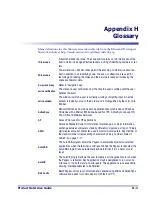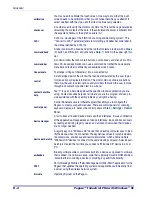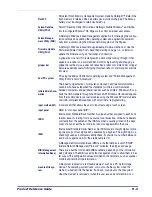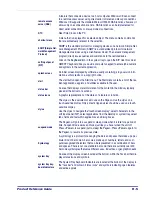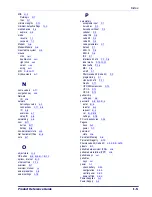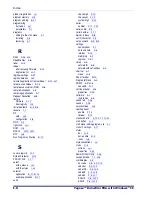
Glossary
H-4
Pegaso™ Industrial PDA with Windows
®
CE
navigation key
A large navigation button (4-way rocker key) on the keypad with 4 arrows: point-
ing up, down, left, and right that allows the user to move the cursor or high-
lighted text entry during menu selection. Press and release one edge of the key
to move the display screen one line or one character in the direction of the
arrow.
Network ID
Here used to mean that you should configure the Windows user settings, such
as the user name, password, and domain name. Microsoft’s definition includes
some wireless network IDs as equivalent to SSIDs.
non-persistent
state
A non-persistent state affects only the next keypress. FN state is a non-persis-
tent state.
object store
The persistent storage that Windows CE makes available to applications. For
example, Windows CE reserves part of its available RAM for the operating sys-
tem and uses the rest for the object store. This data can be stored in files, regis-
try entries, or Windows CE databases.
portable data
assistant (PDA)
A handheld Windows-based (Pocket-PC or Windows CE) computer that can be
synchronized with a host PC to share files and data. Sometimes contains an
infrared device to beam information to another unit.
portable data ter-
minal (PDT)
An industrial strength handheld computer with a keypad, navigation keys, and a
bar code scanner used in inventory, retail, and warehouse activities to collect
data and upload it to a host PC.
Persistent Memory
Persistent Memory is the Pegaso’s flash application and file storage area.
The persistent storage memory persists across all reset (warm/cold reboot)
conditions and software / firmware updates.
persistent state
A state which is maintained after releasing a key. Alpha mode is a persistent
mode. Also called a “sticky” state. A persistent state must be turned off by
pressing the key again.
PRG
Product Reference Guide.
program memory
Memory that is used for stack and heap storage for both system and nonsystem
applications. Nonsystem applications are taken from storage memory, uncom-
pressed, and loaded into program memory for execution.
RF card
A small card-shaped device installed in a Pegaso that allows wireless connec-
tion and communication with a network.
QSG
Quick Start Guide.
RAM (random
access memory)
You can add applications and data files to RAM or into Flash memory via the
"FlashFX" Disk. While Flash memory is persistent (as long as the backup bat-
tery is charged), RAM is not and will be cleared when you remove or replace the
battery. As you can only suspend the device, the only way to turn it fully off is to
remove the battery or to perform a cold reset.
ROM (read only
memory)
The operating system ("Windows CE") and applications are pre-installed on
ROM and cannot be removed or modified. These applications are persistent.
rebar
A command bar with a gripper bar.
Содержание Pegaso
Страница 1: ...Industrial PDA with Windows CE Product Reference Guide ...
Страница 10: ...Preface About this Guide viii Pegaso Industrial PDA with Windows CE NOTES ...
Страница 14: ...Batteries and Power 1 4 Pegaso Industrial PDA with Windows CE NOTES ...
Страница 46: ...Configuring the Pegaso 2 32 Pegaso Industrial PDA with Windows CE NOTES ...
Страница 72: ...Networks Communications and Connections 4 10 Pegaso Industrial PDA with Windows CE NOTES ...
Страница 98: ...Falcon Desktop Utility for Windows CE B 14 Pegaso Industrial PDA with Windows CE NOTES ...
Страница 104: ...Configuring the Web Server C 6 Pegaso Industrial PDA with Windows CE NOTES ...
Страница 132: ...Programming Bar Codes G 8 Pegaso Industrial PDA with Windows CE 2 4 0 4 2 2 0 2 F F 3 E 0 4 2 2 0 4 F F 3 E ...
Страница 156: ...Programming Bar Codes G 32 Pegaso Industrial PDA with Windows CE NOTES ...
Страница 170: ...I 8 Pegaso Industrial PDA with Windows CE Index NOTES ...
Страница 171: ......












